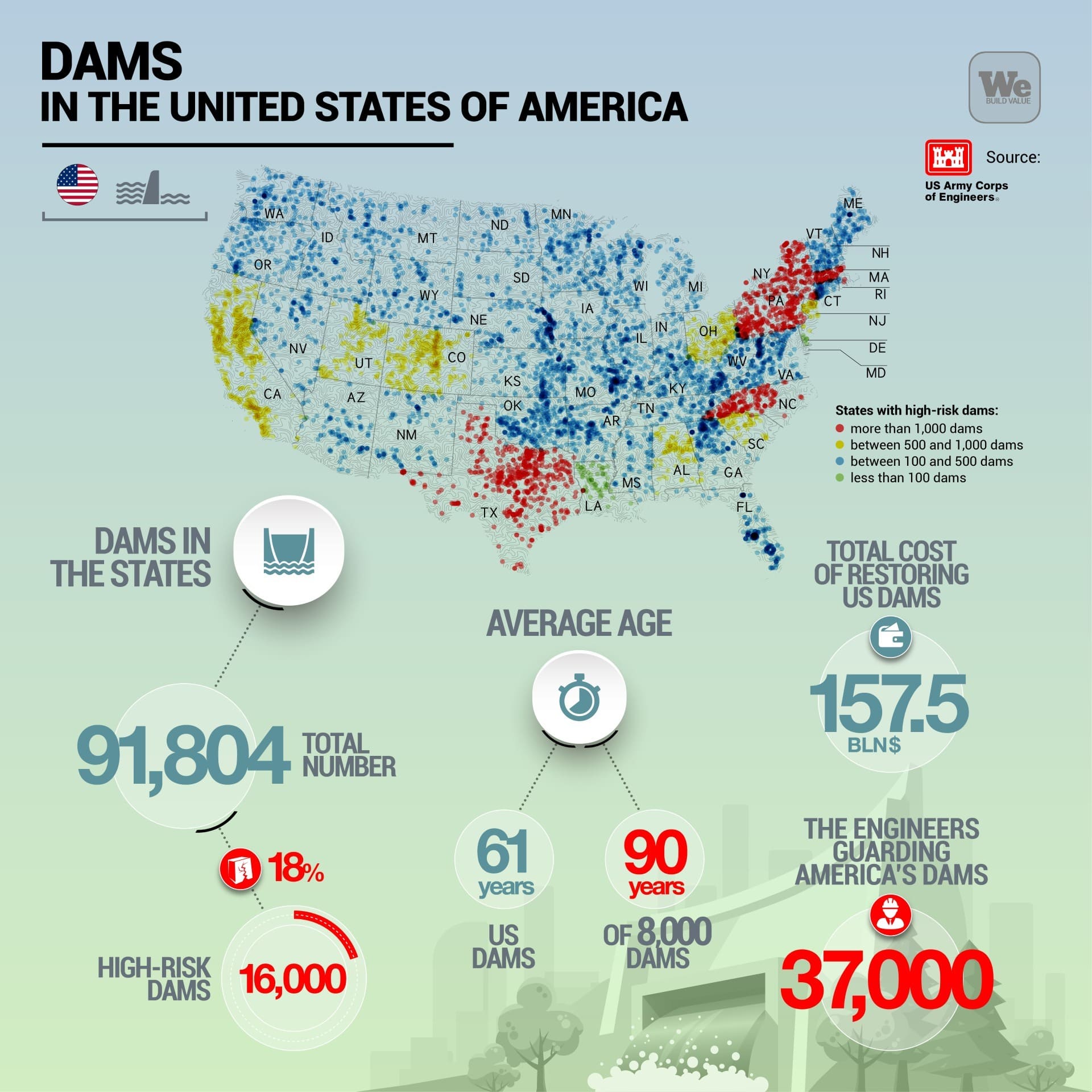Billions of dollars are pouring into American water networks. The Environmental Protection Agency (EPA) has tapped into the funds allocated by the bipartisan Job Act, passed two years ago to accelerate the improvement of an outdated and unsafe infrastructure system. The funds, totaling $7.5 billion, in addition to the 50 billion allocated for water in the last two years, come from the Water Infrastructure Finance and Innovation Act (WIFIA) program, which provides low-interest loans to help communities invest in the construction of drinking water, wastewater, and stormwaterfacilities.
Water infrastructure, especially dams, is among the most critical needs in the country. According to the National Inventory of Dams (NID), there are 91,804 dams in the United States, with an average age of 61 years. Over 8,000 of these dams are over 90 years old, and a significant 17% of them are identified as high-risk. Moreover, it’s a fragmented network of small structures, with about half of the dams in the United States being relatively small, less than 25 feet (7.6 meters) tall. Only 7% are classified as “large dams” (50 feet or higher), and even fewer are large-scale projects like the Hoover Dam.
The 37,000 engineers guarding America’s dams
To manage such a widespread system, the US Army Corps of Engineers (USACE) was called upon in the 1970s. The USACE, following the military hierarchy, reports directly to the President of the United States as the Commander-in-Chief. The Corps consists of 37,000 civilian and military engineers, provides consultancy in over 130 countries worldwide, and plays a central role in the design, construction, and maintenance of American dams.
After the EPA’s announcement, the Corps of Engineers has opened requests to access the WIFIA program, which, since its launch in 2014, has funded 109 projects for a total of $19 billion, creating, according to official figures, 60,000 jobs. The program has reached its seventh edition, and the new $7.5 billion will be prioritized for economically stressed areas, replacing aging service lines, eliminating or reducing so-called “contaminants,” and addressing drought-related interventions.
New funds for disadvantaged communities
For the dams, the new funds will target projects not owned, managed, or maintained by federal entities. They will cover up to 49% of the project costs and 80% will be allocated to disadvantaged communities. According to a study by the Association of State Dam Safety Officials, the cost of restoring over 88,600 non-federal dams with structural deficiencies would be $157.5 billion. States regulate 70% of American dams, and each state has hundreds, if not thousands, of dams within its borders. Federal agencies regulate 5%, while the rest remain unregulated. In terms of ownership, 65% are privately owned, 31% are owned by federal, state, local, or tribal governments, and the rest belong to utilities or have unknown ownership.
The rehabilitation of water infrastructure struggles to keep pace with technical standards, and while technological innovations and downstream development move quickly, dam owners struggle to bear the costs of maintenance or renovation. According to the study, the number of high-risk dams has increased by 20% in the last decade, as deficiencies outpace restoration, reaching over 16,000.
Investments for water works: Webuild’s role
The EPA’s program doesn’t just focus on dams. The announced funds will allow the military engineering corps to improve existing water infrastructure, repair dredging channels in response to floods and coastal storms, and remediate critical areas. Particular attention will be given to projects for collecting and storing excess surface water, managing water releases, minimizing infiltration losses during droughts, and improving wastewater management systems.
The Webuild Group for decades has been at the forefront of this field, realizing some of the most significant water engineering projects in the country, such as the hydraulic tunnel in the center of Lake Mead, designed to provide water to Las Vegas and restore the Colorado River‘s acceptable flow. This river alone provides drinking water to about 10% of the national population and has progressively decreased due to climate change and increased demand from cities and farmers.
Interventions in major American cities with outdated sewage systems that become clogged during storms and untreated water are also critical. In Washington D.C., beneath the Anacostia River, a Potomac tributary, Webuild and its U.S. subsidiary, Lane, have just completed the Northeast Boundary Tunnel (NEBT), designed to improve water quality in rivers around the capital and reduce flooding by managing the flow of rainwater and wastewater effectively, thereby cleaning up the area.
Webuild and Lane’s completed projects and ongoing work are found across the country, from the Dugway Storage Tunnel in Ohio to reduce sewage discharges into the environment and store treated water to the Kuwahee Water Treatment Plant for regulating sanitary sewer flows into the Tennessee River, the Ship Canal Water Quality Project for managing Seattle‘s wastewater and stormwater, the Three Rivers Protection & Overflow Reduction Tunnel for rehabilitating the rivers and the city of Fort Wayne in Indiana, and the West Side CSO Tunnel Project for improving water used by the population of Portland, Oregon.


